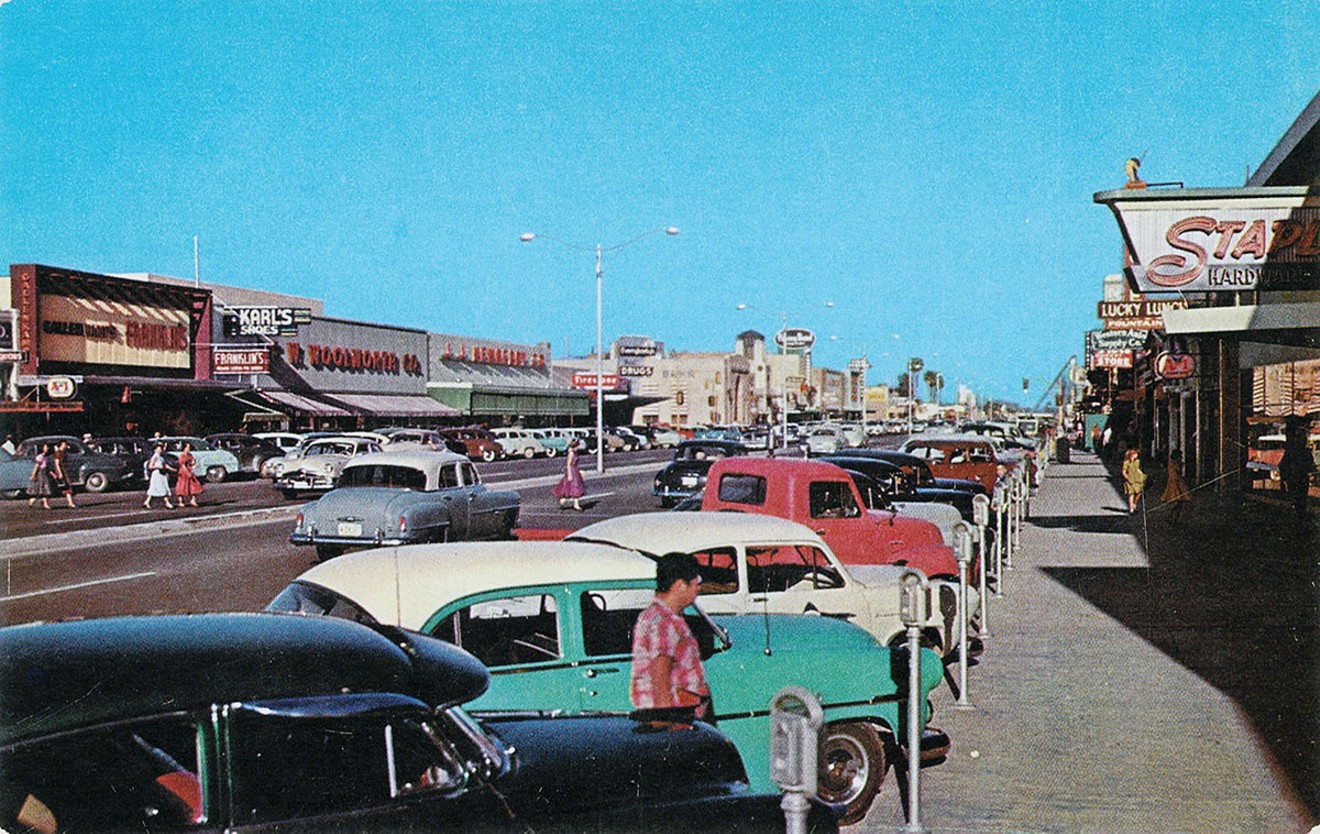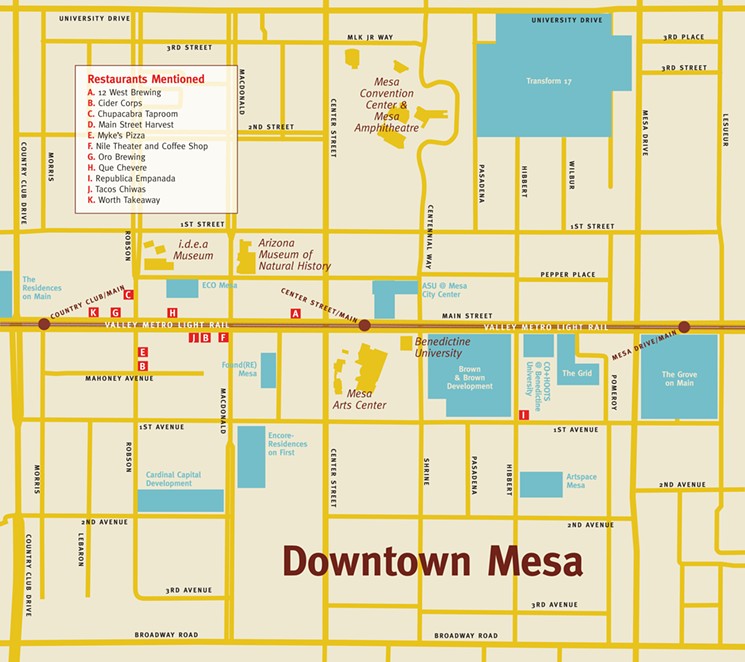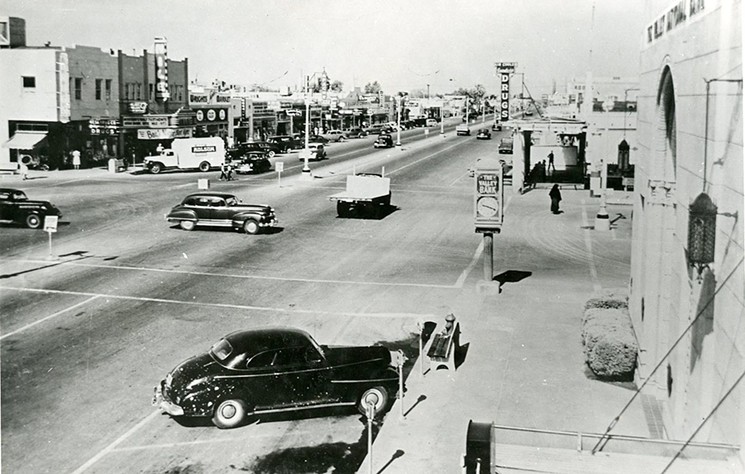
At noon on a weekday, Jeff McVay sits on the street patio outside Worth Takeaway in downtown Mesa, his grilled cheese and tomato soup untouched. People drift by on Main Street's sidewalk, people walking dogs under colonnades, slurping iced coffee, cradling boxes of tacos, curry, and fried chicken. Sun falls. Down the center of the road the Valley Metro light rail rumbles, shaking. Heedless of it all, McVay points at a map, breathlessly explaining.
His map shows downtown Mesa from a hawk's viewpoint. He points to one empty lot where a new multifamily housing unit is rising.
"Three hundred new units," he says.
His finger slides to another lot. "A thousand new units, if the city council approves it this month."
An additional 1,300 residential units are currently slated for construction or already under construction within a short walk of downtown, McVay says. This doesn't include the recently finished Mesa Artspace Lofts, which provide living and studio space for 50 artists and their families. He continues to point across his map to buildings, parks, and other public spaces, cycling through the dozen-plus projects to come to the Main Street corridor.
For the last five years, McVay has been the city of Mesa's "manager of downtown transformation," an economic development role he calls "the best job in the city." He and a team of Mesa employees work to spur downtown's growth and serve as a bridge between the city and local businesses, helping them navigate red tape.
Mesa is huge. It has more people than Miami or Minneapolis. Though less populous than Phoenix (the country's fifth-biggest city), Mesa easily makes the top 50, landing at number 38. Most large metropolitan areas have seen their city centers revitalized and redeveloped over the last few decades. You can see it here in the Valley, too, in downtown Phoenix and downtown Gilbert.
But for years downtown Mesa — roughly, the tract between Country Club and Mesa Drives, University Drive and Broadway Road — lagged far behind those growing town centers.
To explain this, many Mesans pointed to a stigma, to an idea that people look down on Mesa for some reason. It had acquired a reputation as a sleepy place that passed its expiration date long ago, a city hub with little of the magnetism of downtown Phoenix, Scottsdale, or Gilbert.
"Almost any other city of this size, it is a foregone conclusion that it is going to have a cool, vibrant downtown," says Clint Hardison, a Mesa real estate agent. "The notion that we can't sustain a cool, vibrant downtown is unique to this one city."
In recent years, though, a breakthrough at last arrived. New businesses are flooding in. New housing is being constructed. A current of fresh new energy seems to animate Main Street. City life is coming to downtown Mesa.
McVay and his team had the wind at their backs prior to the pandemic. But things seemed to reach a tipping point, somewhat surprisingly, in 2020. As Covid-19 gutted local economies and shuttered small businesses, downtown Mesa continued to see more open. Six new businesses have opened in the first two months of 2021 alone.
"We have so much going on," says Nancy Hormann, president and executive director of the Downtown Mesa Association. "Every other downtown that I talk to — I work with downtowns across the U.S. — they're all losing tenants and not doing very well... We're not losing tenants. We're gaining."
Some hopeful people of downtown Mesa like to talk about bones.
Co-founder of Oro Brewing Dave Valencia says he opened on Main Street due to its "nice bones." Hardison says the long strip "has the bones to support growth." The mayor of Mesa, John Giles, who was born in a downtown hospital, says, "Mesa has always had these amazing bones... It's a real main street, a real downtown." McVay: "The bones are really there."
All this bone chatter might bring to mind entropy, death, some kind of end. But when these people speak of bones, it's in reference to downtown Mesa's network of historical buildings, a skeleton onto which a bustling town center might be fleshed.
Founded in the 1870s, downtown Mesa has already seen a rise and a decline. It evolved from a farming community to a commercial hub where early-1900s laborers building Roosevelt Dam came to purchase supplies, equipment, clothing, and more. Downtown Mesa's bones — its brick buildings from these eras — carry tales of the late-1800s and the happy decades after.
In the years after World War Two, downtown Mesa was the place to be in the east Valley, fueled partly by soldiers who had trained in the area and returned after deployment. Sidewalks brimmed. Mayor Giles recalls Main Street's double-parked cars. Victor Linoff, president of the Mesa Preservation Foundation, estimates that more than 100 neon signs once seared the night sky above Main Street — beckoning from afar to motorists on the nearby freeway, advertising the last town before the open desert.
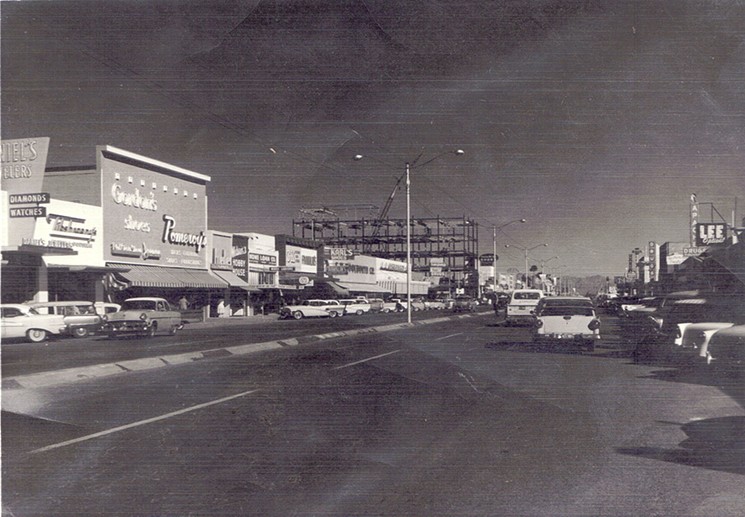
Then the tide turned. By 1970, downtown Mesa had lost its momentum.
Linoff points to the opening of the suburban Tri-City Mall in 1967 and other malls in subsequent years as the catalyst. Following 1967, he says, commerce shifted away from downtown. Linoff calls the Tri-City Mall downtown Mesa's "death knell."
Anything that has experienced its death knell must have bones somewhere, and downtown Mesa's charming timeworn bones standing in plain sight are what, many argue, set it apart from other Valley downtowns. That insight laid the groundwork for the Central Main Plan, approved in 2012.
The Central Main Plan has been the wellspring of many changes now manifesting in downtown Mesa. (McVay's position was created as a result of the plan.) It acts as a supplement to Mesa's general plans, and has "the goal of creating a more active and viable downtown Mesa." It set its crosshairs on the long term, aiming to "manage the change that will occur over the next 15 to 30 years."
The arrival of light rail in downtown Mesa — a lifeline artery to Phoenix and Tempe — was instrumental. The tracks first came online in 2008. In 2015, a 3.1-mile downtown extension opened. Another 1.9 miles opened in 2019.
The Central Main Plan, approved three years before the light rail's downtown extension opened, cast the light rail as foundational to downtown growth.
"While the downtown core contains several exciting and interesting places, they are disconnected and the area as a whole is underdeveloped and underutilized," the plan reads. It goes on to note, in 2012, that the light rail might solve this problem, helping to kick-start "a more active and variable downtown."
Robert Brinton, who has run Matage Custom Framing on Main Street and South Robson for a decade, recalls the excitement about the light rail coming to downtown. "For the first 5, 6, 7 years, it seemed that not much was happening other than the light rail," he says. Like other shop owners, he didn't see much of a boost in foot traffic with the kickoff of the downtown extension. This changed over time.
"Now, in hindsight, it has been amazing to look at what the light rail provided," Brinton says. "It created interest that just wasn't there before."
The benefits of the light rail are twofold. One, the obvious: It helps people get to and from Phoenix without a car. The second is more indirect: In making the Main Street corridor more accessible, light rail enriched downtown in the eyes of investors.
Critically, those investors are now building housing. There are historic homes around Main Street — nice bones, but limited in number. "We have the lowest population density of any square mile in the city of Mesa in the downtown," says McVay. "That's the inverse of what it should be."
Today, developers are adding living units at a rapid pace. New housing includes the GRID (an office-apartment building on 3.3 acres), Eco Mesa (for tenants who prefer ecologically minded living), and many others. "What we aspire to is to have people downtown," says Mayor Giles. "And we have a great strategy now, because we have housing units that are being developed."

McVay and his small staff have a vision that extends to commerce, technology, education, and other facets.
"Downtown, the real goal is to create a downtown innovation district," he says. "Innovation districts are a three-legged stool." City officials crafted Mesa's stool legs, McVay says, after study of other Valley downtowns, especially the growth of downtown Phoenix and how it was spurred by Arizona State University and the light rail.
Leg #1: An anchor institution.
In early 2020, Arizona State University started building a three-story "digital innovation hub" downtown. It will include several departments, notably the recently named Sidney Poitier New American Film School. The city shelled out a whopping $63.5 million for this project, covering all but $10 million of its upfront construction expenses, a move that left some taxpayers peeved. The city, however, saw this as an investment in its residents (a new option for education) and its future (the ASU campus would propel growth).
One year later, Mesa remains bullish. "Huge" is how Mayor Giles describes early returns: the surge in development, the new businesses opening downtown in the wake of ASU's decision. "Once ASU happened and you add that to the list of all the other things going on, people say 'Okay, I need to run to the front of that parade,'" Giles says.
Leg #2: Partnerships.
In addition to forming partnerships with universities like ASU and Benedictine, Mesa has also partnered with new developers and new building owners. The City tends to have close relationships with downtown businesses, including those opened within the last four years, something that many local business owners cite as a boon. Jon Przybyl of Proof Bread, for example, says the city has been instrumental in helping him get his downtown bakery and market going. Armando Hernandez of Tacos Chiwas was stunned that the mayor stopped by shortly after he opened, to congratulate him in person and show support. These kinds of stories are commonplace in downtown Mesa.
Leg #3: Place. The third leg of an innovation district, according to McVay, is that the place has to rock. "It's just about the place," McVay says. "You've got to have the cool restaurants, the coffee shops, the bars, the microbreweries in order for people to want to hang out here."
Main Street now has serious art options (Mesa Arts Center) and boasts, just a few blocks away, one of the top museums in metro Phoenix (Arizona Museum of Natural History).

Less known, however, is that downtown Mesa has become a pocket of stellar eating and drinking.
Within a few blocks' radius on Main Street, you can find some of the Valley's best sandwiches (Worth), pizza (Myke's), cider (Cider Corps), Venezuelan food (Que Chevere), tacos (Tacos Chiwas), empanadas (Republica Empanada), and bread (Main Street Harvest). You can find innovative and well-made beers, anchored by veteran presence Oro Brewing and bolstered by newcomers 12 West Brewing and Chupacabra Taproom.
Only one of these existed in Mesa before the downtown light rail extension opened in 2015. Most of the muscle on the Main Street corridor's food and beverage scene is new.
In a recent restaurant review, I wrote that downtown Mesa, pound-for-pound, pint-for-pint, taco-for-taco can hang with just about anywhere in the Valley. In the months since then, a few more impressive places have opened — and more, the whispers say, are on deck.
In 2020, downtown Mesa's most telling opening was probably Tacos Chiwas. Most bars and restaurants in downtown Mesa have east Valley roots. Tacos Chiwas does not. Here was a great Phoenix taqueria choosing downtown Mesa for an ambitious third location, its first with a bar program. Its arrival may mark a break — a moment after which Phoenix business owners, recognizing downtown Mesa's potential, begin to look east.
"I honestly think people are sleeping on this little area here," says Tacos Chiwas' co-owner Armando Hernandez. Lately, numerous Phoenix restauranteurs have been calling him to ask if they should be opening on Main Street.
Already, Hernandez has been surprised at the pace of change in downtown Mesa. "I'm like, alright, we'll come in and about five years later we'll see some changes," he says. "But we haven't been here a year yet, and we're already starting to see major changes toward something."
Stories about downtown transformations tend to center success, but they're hardly all positive. Just look to downtown Phoenix.
By 2021, Roosevelt Row in particular had metamorphosed into a hub of high-rises, ambitious restaurants, and polished drinkeries. Many of the area's older buildings have been demolished. Rents have soared. Flocks of the creative souls who once called downtown home have migrated to more affordable neighborhoods. There has been good in downtown Phoenix's growth. And yet, it hasn't been all good.
With downtown Mesa on the cusp of becoming a hotbed, it feels inevitable that rents and the cost of living will accelerate — that things will change.
Some locals are anxious.
"Gentrification is going to happen," says McVay. "There's going to be an upward progression on rents. There already is down here. And we don't have a solution. I don't have a solution for it. We're cognizant of it. We know what kind of downtown we want to be. We haven't experienced that problem yet."
Mayor Giles believes that Mesa might be well-positioned to avoid some of growth's negative side effects.
"I think in some ways we aspire for gentrification," Giles says. "What's bad about gentrification is, you know, when you displace communities and people that have an historic connection to a neighborhood. I'm not afraid of that happening in downtown Mesa. The properties that are being redeveloped — some of them are blighted. The historic cultures and people that have lived in those neighborhoods are gone, and we're trying to invite them back."
True, Mesa doesn't have a concentration of downtown residents. But people do live there and nearby, and prices are likely to spike. Though Mesa may have learned from studying other cities, it feels like overly rosy thinking to hope that the growth of a downtown, even a well-positioned downtown, will be overwhelmingly positive.
Still, city officials and some business owners feel that downtown Mesa might be different. It comes down to bones.
Hormann, of the Downtown Mesa Association, notes that developers aren't knocking down the old to build the new. "We're rejuvenating places that have nothing versus taking away something to put there," she says. Like the nearly 10-acre abandoned Chevrolet dealership on Main Street — soon to be, if the city can finalize negotiations with developers, a spread of residential units and shops known as the "Mesa Arts' District Loft."
Mayor Giles emphasizes that Mesa remains "very sensitive to historic preservation."
Michelle Donovan, proprietor of Nile Theater and the Nile Coffee Shop, agrees that the past is one key to the future. "Unless people start demolishing buildings, I don't think the character of the [downtown] mile is in jeopardy of being destroyed," she says.
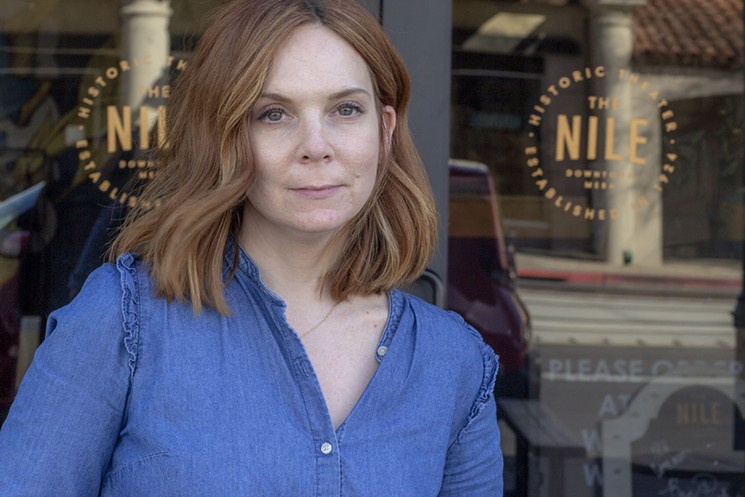
Donovan and others fret chains. With ASU and a flood of students, she fears, the chains might come, contaminating Mesa's gloriously mom-and-pop strip.
"Is there going to be a Starbucks?" Donovan wonders. "Is there going to be a Dutch-Bros-type-of-thing?"
She believes Mesa's independent coffee shops have a charm that will keep people visiting them over any future chains. That charm has roots in Mesa's early days. In the 1980s, the city built hulking concrete colonnades in front of Main Street buildings, now a symbol of the bust days. For many years, one obscured Donovan's building, a regal brick edifice raised in 1924. Through the city of Mesa's recent Downtown Façade Improvement Program, Donovan and other business owners have been able to raze these colonnades and restore the light-rail-facing fronts of old buildings.
Today, the Nile Theatre building stands on Main Street, proud bones looking teleported out of the roaring '20s, like some old urban fairy tale. But whether those well-tended old bones can withstand the coming rush remains to be seen.

